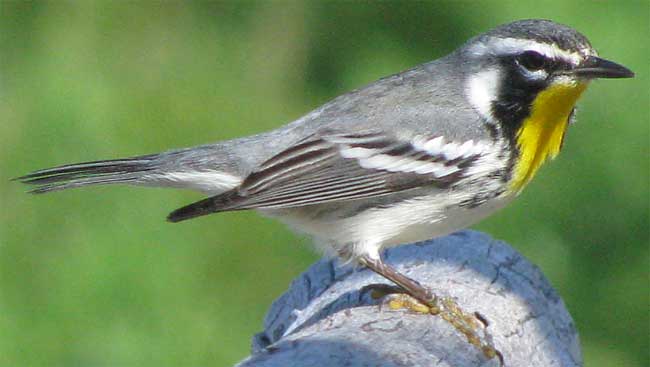Excerpts from Jim Conrad's
Naturalist Newsletter
from the November 5, 2007 Newsletter issued from Yerba Buena Clinic just outside Pueblo Nuevo Solistahuacan, Chiapas, MÉXICO
about 1740 meters in elevation, ± LAT. 17° 11' 27"N, LONG. -92° 53' 35"W
YELLOW-THROATED WARBLER

Last Monday as I issued last week's Newsletter a Yellow-throated Warbler, DENDROICA DOMINICA, landed in the ciber's door and hopped across the muddy, tiled floor to within a foot of my feet. With his yellow throat, white eyebrow and black mask, his identify was unmistakable. That's one above, photographed in the Yucatan.
During my Mississippi hermit days, Yellow-throats were among the first summer residents to arrive in early spring and all summer they kept high in the pines above my trailer, their repetitive calls loud and clear throughout the days. At Hacienda San Juan in the Yucatan they were common and conspicuous high among the fronds of Royal Palms along the entrance road. And now here was this one at my feet on a muddy floor in a cold, rainy Pueblo Nuevo ciber.
Could it sense that the entire upcoming week would be cold and rainy, and that it needed to take unusual risks to locate a dry place?
Back at Yerba Buena I looked up the Yellow-throat's winter distribution. It winters along the US Gulf Coast and the Caribbean, deep into Central America. A funny thing is that in Mexico it winters in the hot lowlands bordering the Gulf of Mexico, as well as here in the Chiapas and Guatemalan highlands, but it avoids the foothills. Why the hot lowlands and the chilly highlands, but not the middle elevations?
I'll bet the ice ages had something to do with this curious overwintering pattern. A wild guess might be that the lowland-wintering population results from migration patterns established after the second-to-the- last Ice Age, while the highland population, to avoid competition with the lowlanders, became established after the last Ice Age, or vice versa.